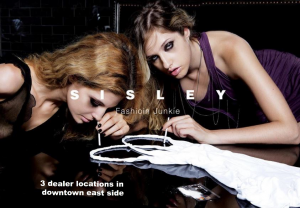Welcome to UBC Blogs. This is your first post. Edit or delete it, then start blogging!
Monthly Archives: February 2018
Culture Jam Assignment

This ad was published by a fashion brand called Sisley in 2007. It became a controversial image because it depicts two dazed off women snorting off clothing, placed in a way to look like cocaine lines. It does not play with subtlety as there is a small bag of cocaine on the side and the caption reads “fashion junkie”. What makes it more overt is that rarely do consumers see a brand marketing on the dark side of drugs and alcohol. They usuallymarket the happy and recreational side of it by showing people laughing, dancing, or partying while using the product. This image capitalizes on the population that are compulsively using addictive substances, and have seen its horrible consequences on their physical and mental health, daily lives, and relationship with loved ones. The stigma around addiction is still prevailing and the term junkie is an offensive word used to degrade those struggling with substance addiction. Addiction is actually termed as “substance use disorder” in the Diagnostic and Statistical Manual of Mental Disorders 5 (DSM V). Therefore, it is important to treat it like a disorder, and not to glamorize it. The creator’s intention was to message that their clothing brand is so great that you will become addicted to it. Or that fashionistas are all “hooked” on their brand. This however, is not a new underlying concept used in advertisements. Many brands have played with the idea that their products can be addicting and enthralling for consumers because addiction is being dependent on something so pleasurable that you lose control. It can successfully draw the attention and interest of a consumer to see at least what the brand is trying to present. However, Sisley crossed the line by their usage of offensive language and overt marketing on a group of people who need professional and medical help.

This image is my jammed version of the advertisement. I aimed to embellish the sense of inappropriateness and ridiculousness of the picture. I continued the analogy and compared their clothing stores to a dealer locations because that is where you meet up to purchase drugs, and a store is where you purchase clothing. Instead of just writing “downtown”, I wrote “downtown east side” because in Vancouver, that region is notoriously known for its high levels of drug abuse. In 2011, crack cocaine was the most commonly used substance, which also resonates with the picture of these girls getting high of it. Another way of interpreting this picture is that these fashion models are supporting their cocaine addiction. The use of cocaine is very common between models in the fashion industry because it is highly addictive and it reduces their appetite. This helps them stay thin in a competitive world where looks and appearance is highly stressed. Since it is not a substance with hallucinating side effects, they can use it while on the job. It is expensive as well, so it has a glamourized appeal to the wealthy class. The jammed caption just turns that seductive and rich life of a model to an advertisement for illicit drugs. The viewer then sees the vacant eyes, the drooping mouth, the hunched over back, and the lack of alertness of the image instead of a beautiful carefree lifestyle of the models.